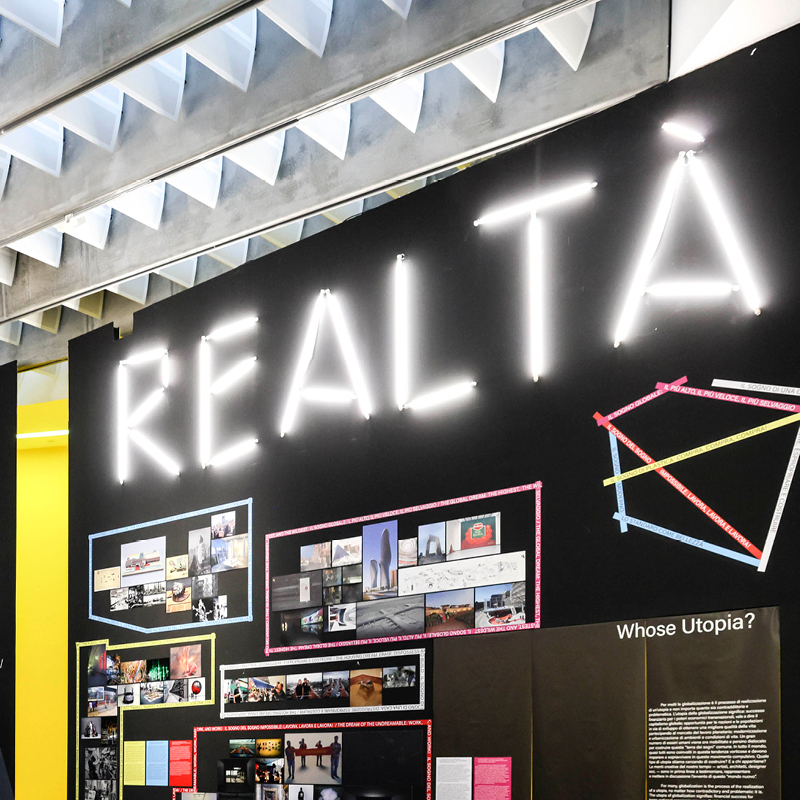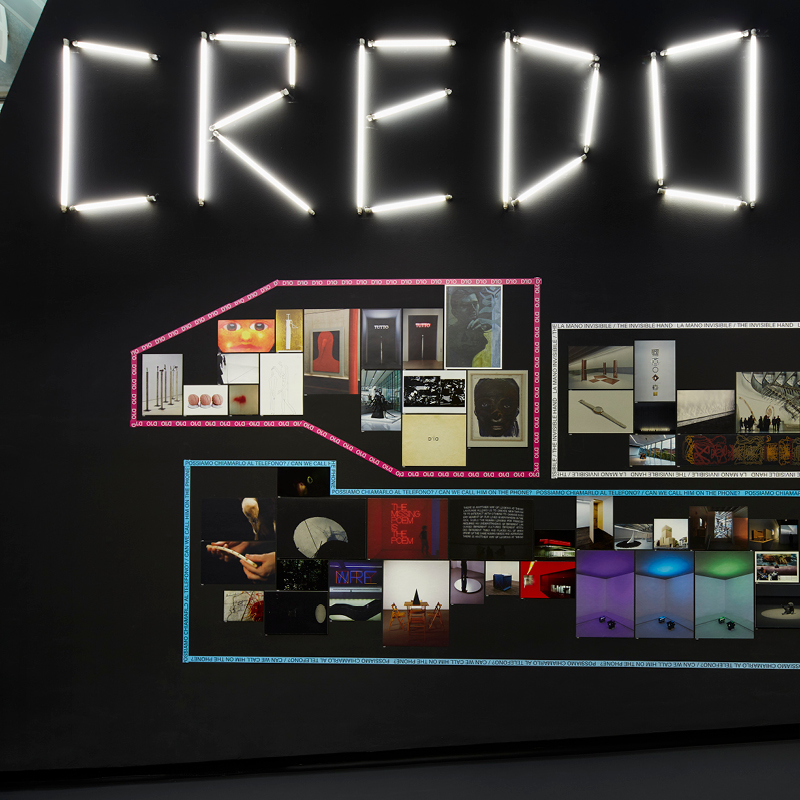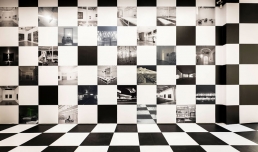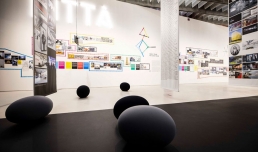A Story for the FutureMAXXI's First Decade
galleria 4
curated by Hou Hanru with MAXXI curatorial and research team
valid until 9 April due to the Museum’s first-floor closing
buy online
the only open ticket, valid for 100 years, for one admission to the Museum and all current exhibitions
buy online
valid for access to the Museum during the last opening hour, available online and at the Museum’s digital ticket point only
upon presentation of the membership Card or Carta EFFE
buy online
minors under 18 years of age; disabled people requiring companion; EU Disability Card holders and accompanying person; MiC employees; European Union tour guides and tour guides, licensed (ref. Circular n.20/2016 DG-Museums); 1 teacher for every 10 students; ICOM members; AMACI members; journalists (who can prove their business activity); myMAXXI membership cardholders; European Union students and university researchers in Art and Architecture, public fine arts academies (AFAM registered) students and Temple University Rome Campus students from Tuesday to Friday (excluding holidays); IED – Istituto Europeo di Design professors, NABA – Nuova Accademia di Belle Arti professors, RUFA – Rome University of Fine Arts professors; upon presentation of ID card or badge – valid for two: Collezione Peggy Guggenheim a Venezia, Castello di Rivoli Museo d’Arte Contemporanea, Sotheby’s Preferred, MEP – Maison Européenne de la Photographie; on your birthday presenting an identity document
for groups of 12 people in the same tour; myMAXXI membership card-holders; registered journalists with valid ID
buy online
under 14 years of age
buy online
disabled people + possible accompanying person; minors under 3 years of age (ticket not required)
book online
MAXXI’s Collection of Art and Architecture represents the founding element of the museum and defines its identity. Since October 2015, it has been on display with different arrangements of works.

galleria 4
curated by Hou Hanru with MAXXI curatorial and research team

MAXXI is a museum dedicated to the twenty-first century arts, namely, contemporary art, architecture, design, and other creative practices, whose definition is being constantly broadened and reinvented. It is an urban museum, an architectural icon conceived by one of the most visionary and boldest architects of the late twentieth century. What’s even more important, it’s a museum that transgresses the border between an artistic institution and the city where it is located. The building was designed as an urban connector, a kind of highway interchange that brings the city to the interior of the museum space, joining urban life and the artistic milieu. In terms of architectural typology, it appears more as an airport terminal rather than a classical museum. Museologically, it incites us to navigate through a completely open, undefined, therefore, uncontrollable, structure in which all forms of activities – exhibition, collection and public interaction, etc. – should be reinvented. This process is addressed to the formation of a new creative social life or a new public life. In other words, MAXXI was founded and developed so that it could become a new Roman Forum of the twenty-first century, in which the values of democracy and its artistic expressions can be produced, shared, and constantly reinvented via the fusion of creative practices between the museum and the city.
This first Atlas unfolds in three chapters: Urbi et Orbi, Upper hand Vs lower hand, and Museum Street / Street Museum,which respectively present the mapping of the process of mapping the coordinate function of the museum as a hub of urban culture, the dialectics between urban planning and everyday life, and the interaction and fusion between the museum and the city where it is located.

MAXXI explores and presents the ways in which artists active in Italy contribute to the evolution of a national creative scene. Rather than define a static national identity, their independent and complex works seek to breathe life into an open territory that is constantly changing, emphasizing the role of artistic and architectural practice in producing a space that is truly contemporary, consmopolitan and global. It’s a space for “living together”. This process reflects the formation of the multitude as the structuring force for our society that, emphasizing the coexistence of diversities, surpasses the logic of nation-state. This is a particularly significant point in our time, when globalization and its impacts need to be rethought in a radical and critical way. Continuing with a long tradition of intellectual commitment – from Spinoza to Paolo Virno, Michael Hardt and Antonio Negri – the concept of multitude, here, needs to be put forward. This transcends the more familiar but now irrelevant idea of the crowd,people, etc., and evaluates and celebrates those who struggle to resist the dominant powers in the name of their own dignity, freedom, and the value of life. This is an alliance of the most diverse voices, especially the marginalized ones, such as those of women, immigrants, sexual minoritie and the poor. All these efforts are closely connected to the destiny of the individuals and the communities that defend independent thinking, action, and creation, namely, the artists.
This chapter of the Atlasunfolds in four sub-chapters: Piazza Italia!offers an overview of the complexity of “Italian imaginary”. Between Mainstream and Marginality explains how the history of art should be rewritten via an evolution in value systems. All the Rainbowspictures how an “national ideal” should be represented by the image of a rainbow. And, Building a Communitydemonstrates the force of creative communities in the development of civil society.

MAXXI is a global institution. Through its projects, it creates its own world by connecting and interacting with “other worlds”: geographical, cultural, anthropological, economic, etc. This allows the institution to play a significant role in the cultural exchanges between individuals, communities, and, in particular, nations, and to explore the possible evolutions of a global scene of creativity. At the heart of the museum’s activity is the search for the changes that invest the “real world”. New cultural and political identities are forged, resulted from the dynamic and conflictual interactions– made up of contrasts, connections, and entanglements– between Italy / Europe and the rest of the world, from the Mediterranean to the Far East via other continents.
The Atlas on display explores the different “worlds” presented at MAXXI: the Mediterranean basin manifested by way of an overview of the some of its most creative cities, such as Teheran, Istanbul, and Beirut (Il Mediterraneo/ The Mediterranean); the global scene observed in its interaction with the local conditions (“Glocali / Glocals”) and based on a twofold perspective for geographical contexts and monographic exhibitions devoted to international artists, groups, and independent spaces (Moltitudine globale/ Global Multitude).
At the same time, a solid and constructive alliance was created between MAXXI and other international institutions via traveling exhibitions and program exchanges. The last chapter in this section is devoted to institutional collaborations (Il MAXXI nel mondo, il mondo nel MAXXI/ MAXXI in the World, the World in MAXXI).
A global multitude is being formed, while the museum is becoming a full-fledged laboratory for the birth of a new era.

In its programs of exhibitions, public events, and educational activitiers, MAXXI has accentuated the importance of the social commitment of the community of artists and architects facing the challenges of a new reality in an era characterized by the globalization of Neoliberal capitalism, geopolitical conflicts and environmental crises. The boom of activities or “creative industries” is intrinsically correlated to the acceleration of this transformation, often a contradictory one, of the world. Contemporary art and architecture are the result of this intense yet paradoxical reality. Indeed, creativity, when it seeks a utopian perspective, cannot be separated from the life of the real world. As a truly contemporary museum, MAXXI has constantly and systematically sought to deal with some of the essential questions of the artistic practice: how real is art? How can art change reality?
These questions are at the heart of the Atlas, which deals with some of the most pressing challenges imposed by today’s reality: the complex interaction between globalization, the economy, work, and migration that defines the contemporary utopia (Whose Utopia?); the issue of the ongoing reconstruction of democracy, which involves both the social and the political dimension of art (Democracy in the Present Tense); the tension, conflicts, violence and even wars that are entangled in the processes of the unfinished emancipation of the oppressed (Unfinished Emancipation); the small problems that afflict everyday life (How to Live with Small Problems); the environmental crisis and the subject of the environment (Too Warm for Bears?).

In recent centuries, unanimous consent, regardless of the type of political and ideological regime, has involved all the technological innovations: believed to be a sign of progress, they have been welcomed and embraced by the masses not just as an instrument for a better life, but also as the trophy of political and cultural achievement. Eventually, through this progess, Man can triumph over God, and replace Him. This is even more true in our own day and age, which is dominated in an unprecedented manner by technology. In the art world as well, two opposite trends paradoxically live together: on the one hand, the need to incorporate new technologies, and, on the other, the affirmation of human primacy over technological control. Within this context, the dialogue with technology and science is reputed to be the most important aspect of the social function of contemporary creative practices, as well as a factor of great appeal for the public. In a certain sense, the technological sphere is replacing the artistic one more and more, offering what is known as an “immersive experience.” This experience is easy to use and therefore perfect for consumption. And the result of this has been the birth of a new type of aesthetic pleasure based on sensational reactions. Nonetheless, there does indeed exist some confusion between artistic creation and technological innovation. They stem from two opposing drives: the former concerns the creation of something out of nothing, while the latter involves the derivation of something from something else. Art professionals today struggle with this important, actually fundamental, equivocation.
The first part of this chapter of the Atlas (Homo Deus) is devoted to critical reflections and incorporation of the role of science and technology in “art making” by raising the question if human intelligence can be elevated to the height of God. At the same time, it is necessary to state that innovation, when applied to a broader field of life, goes well beyond science and technology. Man has never ceased to seek for a certain safe-haven beyond material progress – it’s called spirituality, or mythology, or religion. It’s a question of seeking imaginative thoughts and of proposing alternative actions, so as to be able to explore and understand the world in a truly “reliable” way. The second part of this atlas investigates this dimension “beyond,” the human being’s constant wondering why and how he or she needs to believe (Deus in Homo).
Eventually, we must ask: what is really art? Can art exist in a pure form (Art in Its Pure Form)?

Four colored rooms center on this principal spatial system, offering visitors a sensory experience. The Yellow Room presents the museum’s oral history, featuring interviews with the people who have been a part of the museum’s everyday life. The Pink Room allows visitors to peruse the archive materials, with interventions by the artists and curators involved in the exhibition activities. The White Room is a muffled room where visitors can examine all the publications that have been produced by the museum. Lastly, The Blue Room presents a multimedia landscape of MAXXI’s exhibition history.













A passionate work of research, reflection and debate on the first decade of the 21st century, through the point of view of MAXXI.
City, square, worlds, reality, believe are the neon lights that stand out in the gallery, referring to the five major themes of the exhibition and creating an Atlas that recounts the Museum’s programming in relation to world events.
Visitors are invited to explore the colourful rooms, let themselves be carried away, lose themselves in a galaxy of images, sounds and projections and be an active part of this “collective brainstorming”.
What emerges is a profound link between artistic creation and contemporary reality, also underlined by the collaboration with the ANSA Agency, which has contributed to creating a powerful image-based account of the main events of the decade. The mission of organising this explosion of ideas and stimuli in space was entrusted to the renowned Dutch studio Inside Outside by Petra Blaisse.
header: photo © Agostino Odio
sezioni di mostra / atlanti
MAXXI and the City
The Multitude
Worlds
The Challenges of Reality
Do You Believe in Innovation?
Rooms